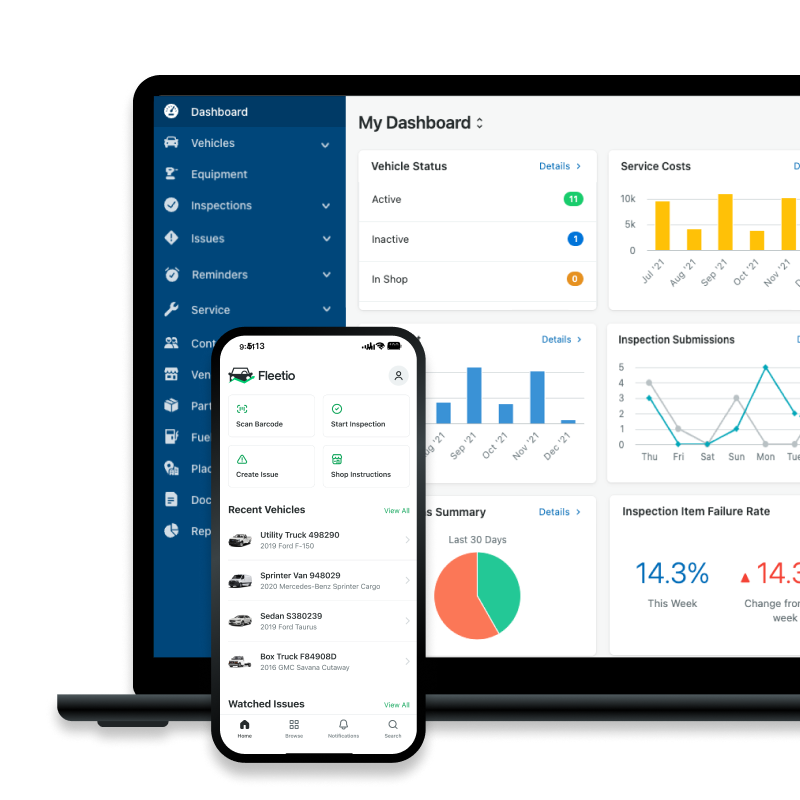Selling Fleet Vehicles: The Essential Service History Checklist for Fleet Managers
Oct 19, 2023
6 min read

Why are vehicle service histories important?
1. Transparency and Trust
A detailed service history demonstrates transparency and builds trust with potential buyers. It shows that you are willing to provide a complete picture of the vehicle’s maintenance and repair records, which can make buyers more confident in their decision.
2. Vehicle Condition
Service histories provide valuable insights into the condition of the fleet vehicles. They reveal whether the vehicles have been well-maintained, which can significantly impact a buyer’s perception of the vehicle’s current state and reliability.
3. Reliability and Performance
A comprehensive service history shows that the vehicles have received regular maintenance, reducing the risk of unexpected downtime. This can be especially appealing to buyers who rely on the vehicles for their operations and want dependable performance.
4. Resale Value
A well-documented service history often means higher resale values – buyers are willing to pay more for vehicles that have been consistently maintained, as it lowers the perceived risk of hidden problems and future repair costs.
5. Compliance and Safety
Many fleet vehicles must adhere to safety and environmental regulations, and having service records that validates your compliance with inspections, emissions tests and safety standards can be a significant selling point.
6. Maintenance Schedule Adherence
Thorough service histories can show that you’ve adhered to the manufacturer’s recommended maintenance schedule, meaning vehicles are less likely to experience mechanical issues.
7. Legal Requirements
In many places, providing a service history is a legal requirement when selling vehicles, especially for businesses and fleet managers. Non-compliance with these regulations can lead to potential legal issues in the sale process, so it’s better to have it squared away beforehand.
8. Competitive Advantage
The used vehicle market is very competitive, but a complete service history can give your fleet vehicles an edge if they’re thorough. Buyers often compare multiple options, and having a complete service history with more information than is simply legally required can make your vehicles stand out.
Tips for Selling Vehicles
Need some pointers on how to organize your vehicle replacement strategy? We can help with that.
Get our free e-bookWhat you need in your service history
1. Maintenance and Repair Records
Start with the essentials. A complete list of maintenance and repair records serves as the foundation of your vehicle service history. It should detail every service or repair, no matter how minor. This list should include:
- Oil changes
- Brake replacements
- Tire rotations
- Transmission services
- Engine repairs
- Suspension work
- Any other routine maintenance or fixes
A detailed service record is a strong selling point, demonstrating that your fleet vehicles have been well-maintained throughout their operational life.
2. Scheduled Maintenance
Ensure that all scheduled maintenance services are documented. This includes major milestones such as:
- 30,000, 60,000, and 90,000-mile services
- Timing belt replacements
- Cooling system flushes
- Air filter replacements
A complete history of scheduled maintenance reflects that you’ve followed the manufacturer’s recommended maintenance schedule. This demonstrates the vehicle is as close to optimal condition as the manufacturer would have intended for anyone purchasing vehicles.
3. Recall and Warranty Repairs
Make sure to include records of any recalls or warranty repairs conducted on the vehicles. This emphasizes that you’ve been diligent in addressing manufacturer-acknowledged issues, assuring potential buyers of vehicle quality and safety.
4. Inspection Reports
Regular inspection reports, such as emissions and safety inspections, should be included in the service history. These reports confirm that the vehicles meet all legal requirements and are safe for operation, and reassures potential buyers that there’s a consistent record of observation on the vehicle.
5. Mileage Logs
Document mileage logs to show how frequently the vehicles were used. Potential buyers often want to know the mileage, so having a log ready is essential to provide a clear picture of vehicle usage.
6. Ownership and Title
Ensure that ownership and title documents are up-to-date. If there are any liens on the vehicles, provide the necessary lien release documents. This documentation is crucial for a smooth transfer of ownership.
7. Proof of Regular Maintenance
If your fleet vehicles were regularly serviced by a third party provider, keep your receipts or invoices. These documents confirm that you’ve invested in the vehicles’ maintenance and that they were serviced by qualified professionals. If you manage maintenance in house, it’s vital to have a consistent system for documenting service, whether it’s in physical logs or a fleet management software.
8. Accident History
If any of the vehicles have been involved in accidents, be transparent about it. Include records of any repairs, and provide information about the accident’s nature and extent. Honesty about the accident history builds trust with potential buyers.
9. Warranty Manuals and Books
Hand over all warranty manuals, owner’s manuals, and service books to the new owner. These documents provide valuable information about the vehicle’s specifications, maintenance schedules, and repair procedures, which can be helpful for future maintenance and repairs.
10. Vehicle Inspection Report
If you’ve had a recent vehicle inspection performed by a qualified technician, share the report with potential buyers. This report can highlight the vehicle’s current condition and any potential issues that might need attention in the near future.
11. Fuel Efficiency Records
Include a log of the vehicle’s fuel efficiency, which can be a significant factor for potential buyers. This log shows that you’ve tracked the vehicle’s performance over time, which can influence a buyer’s decision-making.
12. Records of Upgrades and Modifications
If you made any upgrades or modifications to the vehicles, such as installing new equipment or safety features, document these changes. Buyers may appreciate knowing what improvements have been made and understanding exactly what features they’re paying for.
13. Insurance Documentation
Provide copies of your insurance policies and any accident reports filed. These documents can help potential buyers understand the vehicles’ accident history and insurance claims, if any.
Streamline Fleet Vehicle Handover
Long story short – selling fleet vehicles is straightforward when you have a complete vehicle service history. Comprehensive documentation is not only responsible but also beneficial when offloading fleet vehicles. Potential buyers will appreciate a transparent and comprehensive service history, making it easier to sell your fleet vehicles and potentially securing a better deal.
As a fleet manager, by following this checklist, you can ensure that you have all the essential documentation ready when it’s time to offload your fleet vehicles. Providing a well-documented service history can add credibility to your fleet management practices and simplify the sales process, benefitting both you and the new owners.
Fleet management software can be an incredibly useful tool in maintaining a thorough service history. The right platform allows you to log your inspections digitally and store all of your work orders and other documentation in one single location, so you always have an up-to-date service history. You can even manage your maintenance with PM schedules and automated reminders, so there’s never any unexplained gaps in your service history.
Fleet Maintenance Tracking Software
Manage comprehensive service histories in Fleetio and always have all the information you need to sell off your assets.
Get a free walkthrough
Senior Fleet Content Specialist
As a Senior Fleet Content Specialist at Fleetio, Peyton explores the voices and experiences that shape fleet operations. She focuses on how fleet professionals adopt technology, improve efficiency and lead their teams to bring clarity and context to the challenges happening across the industry.
View articles by Peyton PanikReady to get started?
Join thousands of satisfied customers using Fleetio
Questions? Call us at 1-800-975-5304

